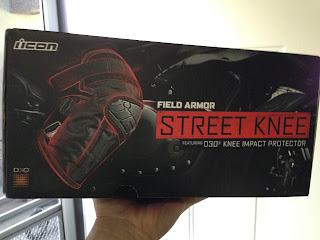Race Gear Report: Tire pressures and the gauges that read them.
Now that I had some initial data on running my Ninja's tires at the track, I wanted to get a better tire gauge so that I could get consistent measurements every session. Like many people I had a tool box full of various tire pressure gauges and no idea how good or bad they were. I grabbed all of my gauges and set about to do some analysis.
I picked this gauge up from the local Cycle Gear. It only ran me $17 or so and is a very nice, but basic unit. The hose has a fixed head like any other normal tire gauge, but the hose is very flexible. The hose is long enough for me to get the gauge in place with one hand and read the dial without craning my neck to see the numbers. The dial is easy to read and comes in single psi graduations. There is a push button release on the side to reset the needle once I've read the pressure. The gauge body is rubber covered for protection which should help to keep from knocking the internal mechanism about causing a loss of accuracy.
Here are the five gauges I'll test against each other. My new one, two of your standard stick type gauges as well as two round dial gauges. Gauge number 4 I got in Japan and is a solid unit that feels like it will do well. Gauge number 5 is a cheap freebie I got from the local bike shop. I have been using it regularly as it is small and seems to work well.
Here are the test results. I used all five gauges and measured the pressures in both the front and rear tires of both the Ninja and the KTM. I did this as the Ninja tires were still at track pressure which was around 18 psi hot off a lap at the track. Now that the tires were cold the pressures were even lower. The KTM runs the pressures in the mid 30 psi range so I was able to test both high and low pressure ranges.
For the first test I was just comparing each gauge to each other. All of the gauges could be wrong, but they could all be wrong together. Here you can see that gauges 1, 2, 3, and 5 were very close to each other after each one was used to measure the pressure three tires per gauge per tire. Gauge 4 was off low every time and wouldn't hold a reading once removed from the tire. After taking all of these measurements I needed something to compare the readings to. Since I don't have any test equipment, I used the KTM's Tire Pressure Monitoring System (TPMS) to show me that my newest gauge seems to be the most accurate, but that my other gauges are close enough for filling up a tire at the gas station.
For future track sessions I can be assured that my pressure readings will be reliable and consistent from session to session. I recommend getting a good gauge as there are reasonably priced ones available in stores and online.
That's it for this post. Stay tuned for more Motorbike Obsessed action coming soon.
Blue





Comments
Post a Comment
Thanks for your comments and for following My Motorbike Obsessions!